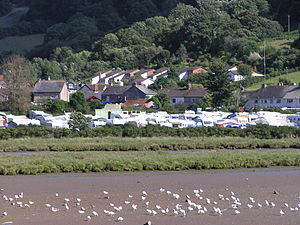Axmouth


Axmouthis a village,civil parishand formermanorin theEast Devondistrict ofDevon,England, near the mouth of theRiver Axe.The village itself is about 1 mile (1.6 km) inland, on the east bank of theAxe estuary.The parish extends along the estuary to the sea, and a significant distance to the east. The village is nearSeatonandBeerwhich are on the other side of the Axe estuary. According to the 2001 census the parish had a population of 493.
History
[edit]In the will ofKing Alfred the Great,a copy of which is in theBritish Library,Axmouth was left to his youngest sonAethelweard.[1]
According toHistoric England,'Axmouth was ranked as a major port by the mid-14th century and accounted for 15% of the country’s shipping trade'.[2] The remains of a late medieval fishing boat can be seen at low tide in the River Axe, just south-west of the village.[2][3]
Historic estates
[edit]Within the parish of Axmouth are various historic estates including:
- Bindon,an ancient seat of the Wyke family, and inherited on marriage to Mary Wyke byWalter Erle (died 1581)ofColcombein the parish ofColytonin Devon, an officer of thePrivy Chamberto King Edward VI and to his sisters Queen Mary I[4]and Queen Elizabeth I.[5][6]Erle purchased the manor of Axmouth following theDissolutionofSyon Monasteryof which it had been a possession.[7]
- Stedcombe Houseis a Grade I listed William and Mary house and estate, to the north of Axmouth village. It was built in about 1697 byRichard Halletton the site of the earlier Stedcombe House, that was destroyed during the English Civil War. The Hallett family acquired the estate in 1691 fromSir Walter YongeofEscot.
Architecture
[edit]
The village includes some thatched cottages, the church has a fifteenth-century tower and a carvedNormandoorway and pillars. TheTudorperiodBindon Houseis nearby and the remains of ahillfortcan be seen on Hawkesdown Hill above the village. An early concrete bridge crosses the mouth of the river close to the harbour which is home to ayacht club.[8]There is also agolf course.
References
[edit]- ^"S1507".Electronic Sawyer.Archived fromthe originalon 4 March 2016.Retrieved26 May2019.
- ^ab"Three Historic Shipwrecks Given Protection".Historic England.15 August 2016.Retrieved26 May2019.
- ^"Three of England's oldest shipwrecks can still be seen on sand and mud in Devon".Culture24.15 August 2016.Retrieved26 May2019.
- ^Pole, Sir William(d.1635), Collections Towards a Description of the County of Devon,Sir John-William de la Pole(ed.), London, 1791, p.123
- ^History of Parliamentbiography of Walter Erle (1586–1665)[1]
- ^"The Henrician Partbooks belonging to Peterhouse, Cambridge (Cambridge University Library, Peterthouse Manuscripts 471-474): A Study, with Restorations of the Incomplete Compositions Contained in them". Submitted by Nicholas John Sandon to the University of Exeter as a dissertation for the degree of Doctor of Philosophy in Music in the Faculty of Arts February 1983. Revised summer 2009 for inclusion in DIAMM (Digital Image Archive of Medieval Music) Source:Chapters I-II[2];Chapter III, Volume I: "The Composers in Ph", pp.81-114, including Walter Erle (d.1581), pp.86-96[3]
- ^Risdon, Tristram(d.1640), Survey of Devon, 1811 edition, London, 1811, with 1810 Additions, pp.25-6
- ^Peter Long (2005).The Hidden Places of Devon.Travel Publishing Ltd.ISBN1-904434-30-4.
External links
[edit] Media related toAxmouthat Wikimedia Commons
Media related toAxmouthat Wikimedia Commons- Devon Local Studies - Axmouth community page
- Axmouthin theDomesday Book
